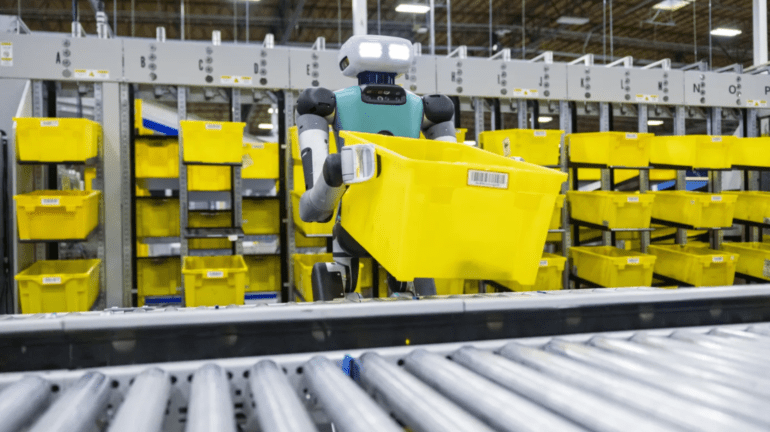TL;DR:
- Amazon is testing Agility’s Digit bipedal robot for use in nationwide fulfillment centers.
- Past examples show Amazon’s cautious approach to technology adoption.
- Amazon’s $1 billion Industrial Innovation Fund hints at their interest in Digit.
- Amazon Robotics is exploring the possibilities of walking robots.
- The company has historically focused on wheeled AMRs for automation.
- Amazon’s influence has driven competition and innovation in the industrial robotics sector.
- Any system integrated into Amazon’s ecosystem must significantly boost productivity.
- Scaling up humanoid robots poses challenges, but startups like Agility are making strides.
- Humanoid robots may align better with existing warehouse setups.
- Amazon is open to combining various technologies for mobile manipulation.
Main AI News:
Amazon has unveiled its plan to put Agility’s bipedal robot, Digit, to the test. The announcement came amid a flurry of updates at the recent Delivering the Future event held in Seattle. This strategic move by Amazon signifies a significant step towards potentially deploying Digit in its extensive network of nationwide fulfillment centers. It’s essential to note that such early-stage collaborations don’t always translate into grand-scale implementations.
An apt example of this cautious approach can be seen in Agility’s initial foray into last-mile delivery with Ford’s pilot program. Eventually, the company shifted its focus solely to employing Digit for warehouse and factory operations.
In April of the preceding year, Amazon included Agility among the initial five beneficiaries of its remarkable $1 billion Industrial Innovation Fund. While this inclusion doesn’t guarantee that Amazon will eventually adopt the technology, it serves as a clear indication of the retail giant’s interest in its potential.
Tye Brady, Amazon Robotics’ Chief Technologist, elaborated on the purpose of the Innovation Fund, emphasizing its role in exploring possibilities in the real world. Furthermore, Brady expressed Amazon’s fascination with walking robots and their potential applications across various terrains. He acknowledged that Amazon is intrigued by both the strengths and weaknesses of humanoid robots, acknowledging the experimental nature of their approach.
Amazon’s primary focus on wheeled Autonomous Mobile Robots (AMRs) dates back to its 2012 acquisition of Kiva Systems, forming the cornerstone of Amazon Robotics. Presently, there are a staggering 750,000 AMRs operational within Amazon’s vast warehouse network. Amazon has also ventured into non-AMR systems, such as picking arms like Sparrow, which was introduced during the same event last year.
Amazon’s significant efforts have had a profound influence on the broader industrial robotics sector. Firstly, Amazon’s commitment to delivering same- and next-day deliveries has put immense pressure on competitors to automate their operations. Secondly, Amazon’s decision to discontinue support for Kiva customers outside its ecosystem led to the emergence of industry leaders like Locus Robotics and 6 River Systems.
To become integrated into Amazon’s growing robotics ecosystem, any system must demonstrate a clear increase in productivity. Amazon prioritizes innovations that expedite the delivery of goods to customers, including exploring the possibilities of drone technology.
The integration of humanoid robots, specifically bipedal robots, into Amazon’s operations, remains a challenging endeavor due to the requirement of matching Amazon’s colossal scale. Several startups are currently competing for supremacy in the humanoid robotics sector, including 1X, Figure, and Tesla. Agility’s Digit, while less human-like in appearance, boasts substantial funding and a significant head start. The company’s recent inauguration of a factory in Salem, Oregon, has the potential to produce up to 100,000 Digits annually when fully operational.
While there is considerable enthusiasm surrounding humanoid robots, scaling up their deployment poses a distinct challenge. The success or failure of Digit in its assigned tasks could profoundly influence the trajectory of humanoid robots in general. Similar to how Kiva Systems catalyzed the rise of AMRs, Amazon’s successful large-scale implementation of Digit could lead to a surge in demand for humanoid workers.
A noteworthy aspect regarding the adoption of humanoid robots is the fact that human workspaces are typically designed for human employees. This includes considerations like shelf heights, terrain, aisle width, and, notably, staircases, which pose challenges for traditional robots. From this perspective, the introduction of humanoid robots aligns more seamlessly with existing brownfield sites—warehouses and factories not originally designed for automation solutions.
It’s worth noting that Amazon possesses the resources to construct tailored facilities, making such limitations less of a concern for the company compared to its competitors. Nevertheless, the ideal scenario involves an effective system that can seamlessly integrate into existing workflows with minimal friction.
Brady emphasized that Digit represents just one facet of Amazon’s plans for mobile manipulation. By amalgamating sensing, computing, and actuation in innovative ways, Amazon seeks to unlock new possibilities. Amazon’s expertise extends to both AMRs and robotic arms, opening up the potential for combining these technologies into a mobile manipulation solution.
Conclusion:
Amazon’s decision to test Agility’s Digit for use in its fulfillment centers is a significant development in the world of bipedal robots. While Amazon has historically been cautious in adopting new technology, its interest in the potential of humanoid robots is evident. This move not only reflects Amazon’s commitment to automation but also has the potential to influence the broader market by driving innovation and competition in the industrial robotics sector. Companies in this space should closely monitor these pilot programs as they may shape the future of humanoid robots in the industry.

